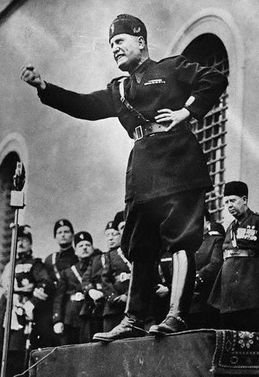Fascism in the last century: History of Democracy
Introduction
Fascism is a political ideology that emerged in the early 20th century, characterized by dictatorial power, extreme nationalism, and the suppression of opposition. This article explores the history of fascism, tracing its origins, dissemination, and eventual decline. We will examine specific examples of fascist regimes, the democratic processes that facilitated their rise to power, and the factors that led to their downfall.

Origins of Fascism
Fascism in the last century is a political doctrine originated in Italy during the aftermath of World War I. Benito Mussolini, a former socialist, founded the Italian Fascist Party in 1919. Mussolini capitalized on widespread discontent, economic instability, and national humiliation following the Treaty of Versailles. Promising to restore Italy’s grandeur, Mussolini’s ideology combined nationalism, militarism, anti-communism, and authoritarianism.
Dissemination of Fascism in the last century, Around the World
Germany
The most notorious example of fascism’s spread is Nazi Germany. Adolf Hitler, inspired by Mussolini, transformed the National Socialist German Workers’ Party (NSDAP) into a powerful political force. Economic despair, hyperinflation, and the Treaty of Versailles’ harsh terms fueled support for Hitler, who promised to revive Germany’s economy and restore national pride.

Spain
In Spain, Francisco Franco led a military coup against the democratically elected government, resulting in the Spanish Civil War (1936-1939). With support from Nazi Germany and Fascist Italy, Franco established a fascist regime that lasted until his death in 1975.

Japan
Fascist ideologies also influenced Japan, where militaristic and nationalist sentiments led to the rise of leaders like Hideki Tojo. The Japanese government adopted fascist principles, emphasizing loyalty to the emperor and military expansionism, culminating in its involvement in World War II.

Other Countries
Fascist movements on the last century, emerged in various other countries, including Hungary under Miklós Horthy, Romania under Ion Antonescu, and Austria under Engelbert Dollfuss. These regimes shared common traits such as authoritarian rule, nationalist rhetoric, and the suppression of dissent.
Democratic Processes and Fascism in the last century
Fascist leaders often exploited democratic processes to gain power. Mussolini and Hitler, for instance, initially used democratic means to achieve their goals.
Italy
Mussolini’s rise to power began with the March on Rome in 1922. Although the march was a display of force, King Victor Emmanuel III invited Mussolini to form a government, believing he could control the fascists. Mussolini gradually dismantled democratic institutions, establishing a dictatorship.

Germany
Hitler’s ascent was facilitated by the Weimar Republic’s weaknesses. The Nazi Party gained significant seats in the Reichstag, and in 1933, President Paul von Hindenburg appointed Hitler as Chancellor. The Reichstag Fire later that year enabled Hitler to push through the Reichstag Fire Decree and the Enabling Act, granting him dictatorial powers.

Spain
Franco’s rise was marked by the Spanish Civil War. Unlike Mussolini and Hitler, Franco’s ascent was through a violent overthrow rather than democratic processes. However, his regime maintained a veneer of legitimacy by holding referendums and manipulating electoral processes.

Actions and Policies of Fascism on the last century
Italy
Mussolini implemented policies aimed at consolidating power and transforming Italian society. These included:
- The Corporate State: Mussolini established a corporatist economy, where the state controlled industries, labor unions, and employers’ associations.
- Propaganda and Censorship: The regime used propaganda to promote fascist ideals and censored opposition.
- Expansionism: Mussolini sought to expand Italian territory, leading to the invasion of Ethiopia in 1935.
Germany
Hitler’s regime was marked by:
- Anti-Semitic Policies: The Nuremberg Laws of 1935 institutionalized racial discrimination against Jews, culminating in the Holocaust.
- Economic Policies: The Nazis implemented policies to reduce unemployment and revive the economy, such as public works projects and rearmament.
- Military Expansion: Hitler pursued aggressive expansionism, leading to World War II with the invasion of Poland in 1939.
Spain
Franco’s Spain saw:
- Repression of Dissent: Franco’s regime brutally suppressed opposition, executing or imprisoning thousands of political dissidents.
- Cultural Policies: Franco promoted Spanish nationalism and Catholicism, suppressing regional languages and cultures.
- Neutrality in WWII: Despite ideological similarities, Franco maintained Spanish neutrality during World War II.
Decline and Fall of Fascism on the last century
Italy
Mussolini’s downfall began with Italy’s failures in World War II. In 1943, the Allies invaded Sicily, leading to Mussolini’s arrest and the collapse of his regime. Although he briefly led a puppet state in Northern Italy, he was captured and executed by Italian partisans in 1945.
Germany
Nazi Germany’s fall was primarily due to its military defeats in World War II. The Allied invasion of Normandy in 1944 and the Soviet advance from the east crushed German forces. Hitler committed suicide in April 1945, and Germany surrendered shortly after.
Spain
Franco remained in power until his death in 1975. His regime transitioned Spain to democracy through a series of reforms initiated by his successor, King Juan Carlos I. Unlike other fascist leaders, Franco’s regime ended through a relatively peaceful transition rather than military defeat.
Conclusion
Fascism emerged in the early 20th century as a reaction to political and economic instability, promising national rejuvenation and strong leadership. Fascist leaders like Mussolini, Hitler, and Franco exploited democratic processes and societal discontent to seize power. Their regimes were characterized by authoritarianism, nationalism, and suppression of dissent. Ultimately, their aggressive expansionism and repressive policies led to their downfall, leaving a legacy of devastation and a stark warning about the dangers of totalitarian ideologies.
References
Griffin, Roger. The Nature of Fascism. Routledge, 1993.
Paxton, Robert O. The Anatomy of Fascism. Vintage Books, 2004.
Payne, Stanley G. A History of Fascism, 1914-1945. University of Wisconsin Press, 1995.
Kershaw, Ian. Hitler: A Biography. W.W. Norton & Company, 2008.
Bosworth, R.J.B. Mussolini’s Italy: Life Under the Fascist Dictatorship, 1915-1945. Penguin Books, 2006.
Bibliographical References
- Griffin, Roger. The Nature of Fascism. Routledge, 1993.
- Paxton, Robert O. The Anatomy of Fascism. Vintage Books, 2004.
- Kershaw, Ian. Hitler: A Biography. W.W. Norton & Company, 2008.
- Payne, Stanley G. A History of Fascism, 1914-1945. University of Wisconsin Press, 1995.
- Bosworth, R.J.B. Mussolini’s Italy: Life Under the Fascist Dictatorship, 1915-1945. Penguin Books, 2006.
- Eatwell, Roger. Fascism: A History. Penguin Books, 1997.
- Blinkhorn, Martin. Fascists and Conservatives: The Radical Right and the Establishment in Twentieth-Century Europe. Routledge, 1990.
- Nolte, Ernst. Three Faces of Fascism: Action Française, Italian Fascism, National Socialism. New American Library, 1966.
- Sternhell, Zeev. Neither Right nor Left: Fascist Ideology in France. Princeton University Press, 1986.
- Tismaneanu, Vladimir. Fascism, Communism, and the Consolidation of Democracy: A Comparison of European Dictatorships. Cambridge University Press, 2006.
- Overy, Richard. The Dictators: Hitler’s Germany and Stalin’s Russia. W.W. Norton & Company, 2004.
- Laqueur, Walter. Fascism: Past, Present, Future. Oxford University Press, 1996.
- Mann, Michael. Fascists. Cambridge University Press, 2004.
- Evans, Richard J. The Third Reich Trilogy: The Coming of the Third Reich, The Third Reich in Power, The Third Reich at War. Penguin Books, 2003-2008.
- Gellately, Robert. Backing Hitler: Consent and Coercion in Nazi Germany. Oxford University Press, 2001.
- Burleigh, Michael. The Third Reich: A New History. Hill and Wang, 2000.
- Kershaw, Ian. To Hell and Back: Europe 1914-1949. Viking, 2015.
- Lewis, Paul. Latin Fascist Elites: The Mussolini, Franco, and Salazar Regimes. Praeger, 2002.
- Ciano, Galeazzo. The Ciano Diaries 1939-1943. Doubleday, 1946.
- Fest, Joachim C. Inside Hitler’s Bunker: The Last Days of the Third Reich. Farrar, Straus and Giroux, 2004.








